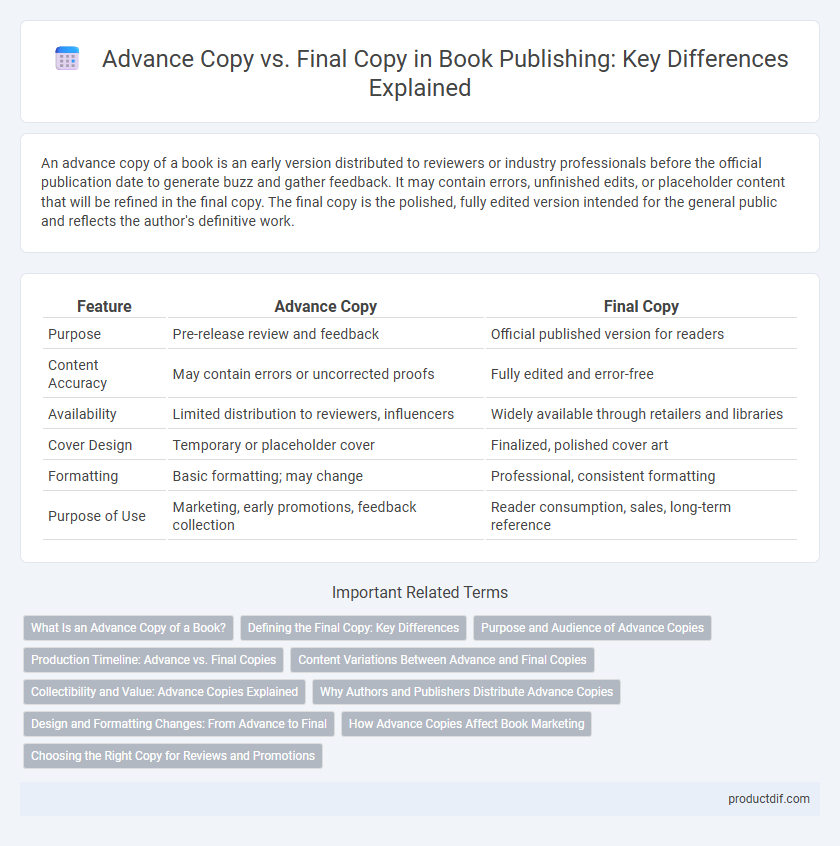An advance copy of a book is an early version distributed to reviewers or industry professionals before the official publication date to generate buzz and gather feedback. It may contain errors, unfinished edits, or placeholder content that will be refined in the final copy. The final copy is the polished, fully edited version intended for the general public and reflects the author's definitive work.
Table of Comparison
| Feature | Advance Copy | Final Copy |
|---|---|---|
| Purpose | Pre-release review and feedback | Official published version for readers |
| Content Accuracy | May contain errors or uncorrected proofs | Fully edited and error-free |
| Availability | Limited distribution to reviewers, influencers | Widely available through retailers and libraries |
| Cover Design | Temporary or placeholder cover | Finalized, polished cover art |
| Formatting | Basic formatting; may change | Professional, consistent formatting |
| Purpose of Use | Marketing, early promotions, feedback collection | Reader consumption, sales, long-term reference |
What Is an Advance Copy of a Book?
An advance copy of a book, also known as an advance reader copy (ARC), is an early version of a manuscript distributed before the final print edition. It is used for promotional purposes, allowing reviewers, bookstores, and influencers to evaluate the content and generate buzz prior to the official release. Unlike the final copy, advance copies may contain minor errors or uncorrected proofs that will be refined in the published edition.
Defining the Final Copy: Key Differences
The final copy of a book represents the fully edited and polished version, incorporating all author revisions, professional proofreading, and design elements, making it ready for publication and distribution. In contrast to an advance copy, which often serves as an early review or promotional tool, the final copy ensures accuracy in content, layout, and formatting to meet publisher standards and reader expectations. This version is the authoritative text used for printing, digital release, and archiving.
Purpose and Audience of Advance Copies
Advance copies serve the purpose of generating early reviews and buzz among critics, booksellers, and influencers before the official release date. These copies target industry professionals, reviewers, and media to build anticipation and secure endorsements. Unlike final copies, advance copies may contain uncorrected proofs or minor errors, emphasizing their role as promotional tools rather than polished products for general readers.
Production Timeline: Advance vs. Final Copies
Advance copies are produced earlier in the publishing process, often months before the final version is completed, allowing for early reviews and marketing efforts. Final copies undergo thorough editing, formatting, and quality checks, resulting in a polished product ready for distribution to the general public. The production timeline for advance copies is shorter and prioritizes speed, while final copies focus on accuracy and presentation.
Content Variations Between Advance and Final Copies
Advance copies of books often contain uncorrected proofs, leading to potential content variations such as typographical errors, incomplete chapters, or formatting inconsistencies compared to final copies. Final copies undergo comprehensive editing, proofreading, and layout adjustments, resulting in polished text and accurate pagination. Publishers use advance copies primarily for review and marketing purposes, so content may differ significantly from the finalized, widely distributed editions.
Collectibility and Value: Advance Copies Explained
Advance copies of books, often known as ARCs (Advance Reader Copies), are pre-publication versions distributed to reviewers and influencers, making them highly collectible due to their limited availability and unique cover designs. Unlike final copies, ARCs may contain errors or differences from the published edition, which can increase their value among collectors seeking rare and original editions. The scarcity and early release status of advance copies contribute significantly to their market demand and potential appreciation over time.
Why Authors and Publishers Distribute Advance Copies
Authors and publishers distribute advance copies to generate early reviews and build buzz prior to the final release, improving market visibility. Advance copies allow editors, critics, and influencers to provide feedback and endorsements that can influence sales and reader anticipation. This strategic distribution helps identify potential issues and fine-tune the final copy for maximum impact upon publication.
Design and Formatting Changes: From Advance to Final
Advance copies often feature preliminary design and formatting that prioritize content review over polished aesthetics, including placeholder images, temporary fonts, and provisional layouts. Final copies undergo meticulous refinements such as precise typography adjustments, high-resolution graphics integration, and consistent margin and spacing standards to enhance readability and visual appeal. These design and formatting enhancements in the final copy ensure the book meets professional publishing standards and provides a seamless reader experience.
How Advance Copies Affect Book Marketing
Advance copies, also known as ARCs (Advance Reader Copies), play a crucial role in book marketing by generating early buzz and authentic reviews before the official release date. These pre-publication copies enable authors and publishers to engage influencers, book bloggers, and reviewers, creating anticipation and increasing visibility in competitive markets. Effective use of advance copies can significantly boost pre-orders and initial sales, influencing bestseller rankings and overall market traction.
Choosing the Right Copy for Reviews and Promotions
Advance copies, also known as advance reader copies (ARCs), are distributed before the final edits and design are complete, allowing reviewers and influencers to generate early buzz and gather feedback. Final copies feature polished content, finalized formatting, and corrected errors, making them ideal for official promotions and public sales. Choosing an ARC facilitates timely reviews and builds anticipation, while using the final copy ensures a consistently high-quality reader experience and accurate representation of the book.
Advance Copy vs Final Copy Infographic

 productdif.com
productdif.com